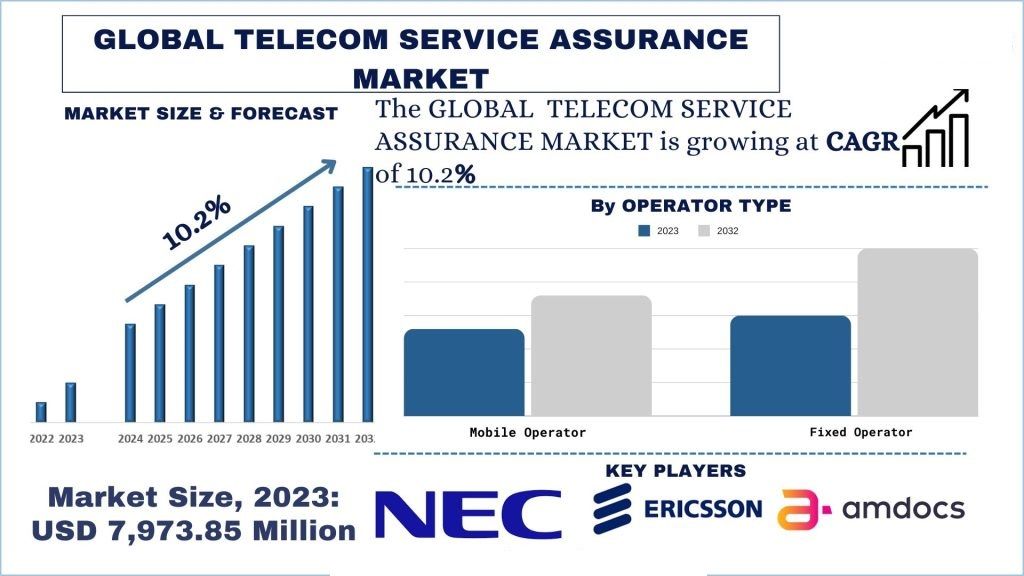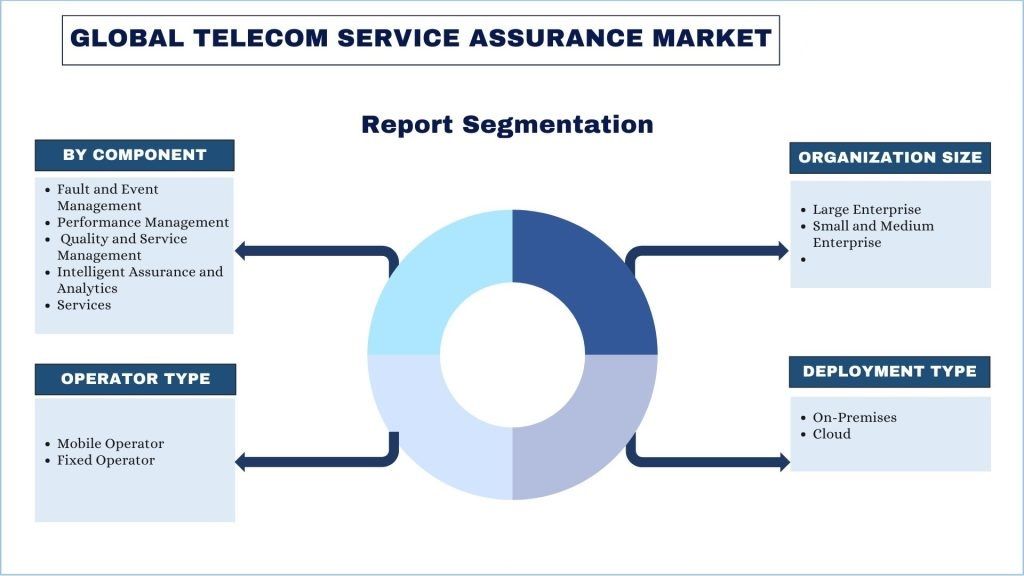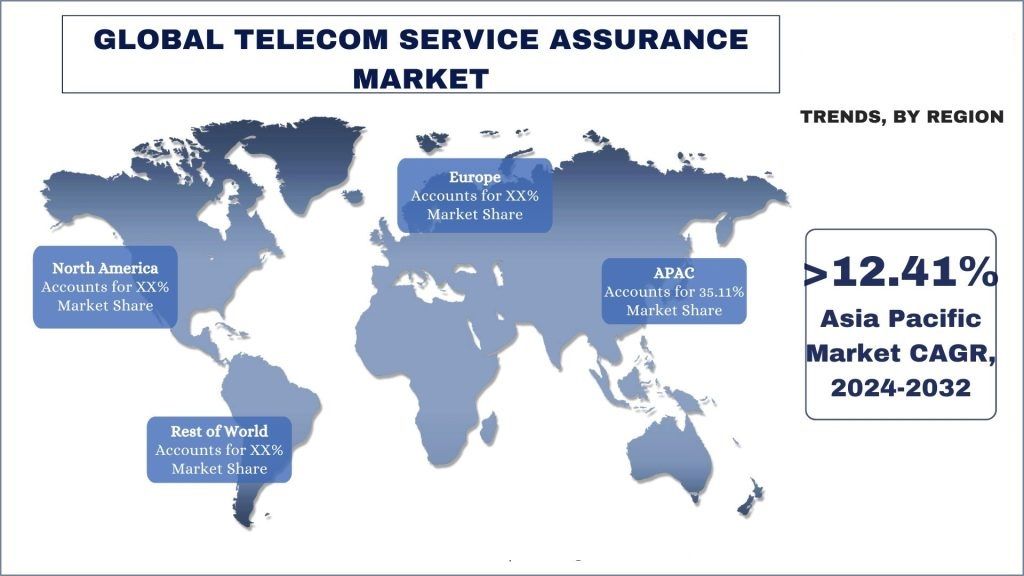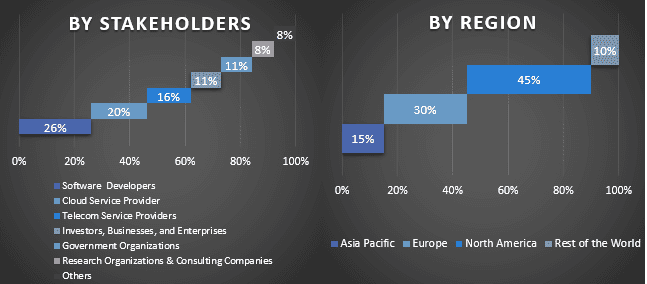- Home
- About Us
- Industry
- Services
- Reading
- Contact Us
Telecom Service Assurance Market: Current Analysis and Forecast (2024-2032)
Emphasis on Component (Fault and Event Management, Performance Management, Quality, and Service Management, Intelligent Assurance and Analytics, and Services); Operator Type (Mobile and Fixed Operators); Organization Size (Large Enterprises and Small and Medium Enterprises); Deployment Type (On-Premise and Cloud) and Region/Country

Telecom Service Assurance Market Size & Forecast
The telecom service assurance market was valued at USD 7,973.85 Million and is expected to grow at a strong CAGR of around 10.2% during the forecast period (2024-2032) owing to the growing data consumption and rising proliferation of internet users globally.
Telecom Service Assurance Market Analysis
Telecom service assurance (SA) refers to the set of processes, tools, and technologies that telecommunications providers use to deliver high-quality, reliable, and consistent services to their customers. The primary goals of service assurance in the telecom industry are to continuously monitor and optimize network performance to meet or exceed defined service level agreements (SLAs) and ensure a positive customer experience. Furthermore, streamlines network operations, reduces operational costs, and improves overall business agility through automation and data-driven decision-making.
As the world becomes increasingly interconnected through digital technologies, the demand for reliable and high-quality telecommunication services has never been higher. Telecom operators are under immense pressure to ensure their networks and services are functioning optimally to meet the evolving needs of consumers and businesses. This has led to a growing emphasis on telecom operator assurance, a critical discipline that helps telecom providers maintain service quality, improve customer satisfaction, and drive operational efficiency. Exponential data consumption is a major factor driving the growth of the industry. The surge in video streaming, mobile gaming, and the proliferation of smart devices are primary contributors to the skyrocketing data consumption. For instance, as per the report by Ericsson Mobile, total mobile data traffic is estimated to grow from 26 EB per month in 2023 to 73 EB per month in 2029, growing at a strong CAGR of 19 percent. Furthermore, The deployment of 5G networks and the rapid growth of the Internet of Things (IoT) are creating new challenges for telecom operators. 5G networks require more sophisticated network management and service assurance capabilities to ensure consistent quality of experience (QoE) for users, necessitating the need for telecom service assurance. For instance, the number of IoT devices is expected to reach 29.3 billion by 2023, up from 18.4 billion in 2020, according to the International Data Corporation (IDC). Additionally, telecom operators are under constant pressure to optimize costs and improve operational efficiency to maintain profitability. Effective telecom operator assurance can help identify and address issues proactively, reducing operational expenses and improving overall efficiency. Factors such as these are fostering a conducive environment, influencing the need for reliable telecom service assurance operators across various markets.

Telecom Service Assurance Market Trends
This section discusses the key market trends that are influencing the various segments of the Telecom Service Assurance Market as identified by our team of research experts.
Performance management emerges as a major component driving the demand for Telecom Service Assurance across various markets.
The performance management segment often generates the major portion of revenue for telecom service assurance operators across various markets. Performance management in telecom service assurance involves monitoring and controlling the efficiency of the network. It addresses throughput, reduces network bottlenecks, and handles potential issues. The demand for high-quality services is the major factor influencing the demand. In today’s competitive marketplace, maintaining high-quality standards is more crucial than ever. Customers demand reliable and efficient services, and performance management systems are designed to meet these demands. Furthermore, performance management systems provide a framework for continuous evaluation and improvement of organizational operations. This continuous improvement leads to enhanced service delivery, which attracts and retains customers, thereby generating revenue. These are some of the major driving factors influencing the demand for performance management across various markets.
Asia Pacific stands out as the fastest-growing market for Telecom Service Assurance globally.
The Asia Pacific region, particularly countries like China, Japan, and South Korea, is a hotbed for technological innovation. These countries are at the forefront of advancements in 5G technology. China, for instance, is expected to have over 600 million 5G subscribers by 2025. This rapid adoption of 5G is driving the need for robust telecom service assurance solutions to manage the complex network infrastructure and ensure seamless service delivery. Furthermore, the region is home to some of the world’s most populous countries, including China and India. With increasing mobile and internet penetration in these countries, the demand for telecom services is skyrocketing. As of 2023, the number of smartphone users in the Asia Pacific region is projected to reach 1.1 billion, with India and China accounting for the majority. This massive user base necessitates effective service assurance solutions to maintain network performance and customer satisfaction. Additionally, government policies in the Asia Pacific region also play a crucial role in the growth of the telecom service assurance market. Governments are actively promoting digital transformation and the adoption of advanced technologies like 5G. For instance, the Indian government’s ‘Digital India’ initiative aims to transform the country into a digitally empowered society, fostering the growth of the telecom sector. Further, contributes to the widespread adoption of telecom service assurance across the region.

Telecom Service Assurance Industry Overview
The telecom service assurance market is competitive and fragmented, with the presence of several global and international market players. The key players are adopting different growth strategies to enhance their market presence, such as partnerships, agreements, collaborations, new product launches, geographical expansions, and mergers and acquisitions. Some of the major players operating in the market are NEC Corporation; Telefonaktiebolaget LM Ericsson; Amdocs; NETSCOUT; Broadcom; Hewlett Packard Enterprise Development LP; Accenture; Comarch SA.; Huawei Technologies Co., Ltd; and Nokia.
Telecom Service Assurance Market News
In February 2024, VMware, which was recently acquired by Broadcom Inc., revealed that DISH Wireless had implemented VMware Telco Cloud Service Assurance on the Boost Wireless Network in a trial production setting. This deployment aims to offer real-time network monitoring, assurance, and automation, enhancing the quality of the 5G network and subscriber experience. According to Eben Albertyn, EVP and Chief Technology Officer, “DISH Wireless operates its network traffic in a multi-vendor, cloud-native environment and has already launched over 20,000 5G sites.”
Telecom Service Assurance Market Report Coverage

Reasons to buy this report:
- The study includes market sizing and forecasting analysis validated by authenticated key industry experts.
- The report presents a quick review of overall industry performance at one glance.
- The report covers an in-depth analysis of prominent industry peers with a primary focus on key business financials, product portfolios, expansion strategies, and recent developments.
- Detailed examination of drivers, restraints, key trends, and opportunities prevailing in the industry.
- The study comprehensively covers the market across different segments.
- Deep dive regional level analysis of the industry.
Customization Options:
The global Telecom Service Assurance market can further be customized as per the requirement or any other market segment. Besides this, UMI understands that you may have your own business needs; hence, feel free to contact us to get a report that completely suits your requirements.
Table of Content
Research Methodology for the Telecom Service Assurance Market Analysis (2024-2032)
Analyzing the historical market, estimating the current market, and forecasting the future market of the global Telecom Service Assurance market were the three major steps undertaken to create and analyze the adoption of telecom service assurances in major regions globally. Exhaustive secondary research was conducted to collect the historical market numbers and estimate the current market size. Secondly, to validate these insights, numerous findings and assumptions were taken into consideration. Moreover, exhaustive primary interviews were also conducted with industry experts across the value chain of the global Telecom Service Assurance market. Post assumption and validation of market numbers through primary interviews, we employed a top-down/bottom-up approach to forecasting the complete market size. Thereafter, market breakdown and data triangulation methods were adopted to estimate and analyze the market size of segments and sub-segments of the industry pertains to. Detailed methodology is explained below:
Analysis of Historical Market Size
Step 1: In-Depth Study of Secondary Sources:
A detailed secondary study was conducted to obtain the historical market size of the Telecom Service Assurance market through company internal sources such as annual reports & financial statements, performance presentations, press releases, etc., and external sources including journals, news & articles, government publications, competitor publications, sector reports, third-party database, and other credible publications.
Step 2: Market Segmentation:
After obtaining the historical market size of the Telecom Service Assurance market, we conducted a detailed secondary analysis to gather historical market insights and share for different segments & sub-segments for major regions. Major segments are included in the report, such as component, operator type, organization size, and deployment type. Further country-level analyses were conducted to evaluate the overall adoption of testing models in that region.
Step 3: Factor Analysis:
After acquiring the historical market size of different segments and sub-segments, we conducted a detailed factor analysis to estimate the current market size of the Telecom Service Assurance market. Further, we conducted factor analysis using dependent and independent variables such as the component, operator type, organization size, and deployment type of the Telecom Service Assurance market. A thorough analysis was conducted of demand and supply-side scenarios considering top partnerships, mergers and acquisitions, business expansion, and product launches in the Telecom Service Assurance market sector across the globe.
Current Market Size Estimate & Forecast
Current Market Sizing: Based on actionable insights from the above 3 steps, we arrived at the current market size, key players in the global Telecom Service Assurance market, and market shares of the segments. All the required percentage shares split and market breakdowns were determined using the above-mentioned secondary approach and were verified through primary interviews.
Estimation & Forecasting: For market estimation and forecast, weights were assigned to different factors including drivers & trends, restraints, and opportunities available for the stakeholders. After analyzing these factors, relevant forecasting techniques, i.e., the top-down/bottom-up approach, were applied to arrive at the market forecast for 2032 for different segments and sub-segments across the major markets globally. The research methodology adopted to estimate the market size encompasses:
- The industry’s market size, in terms of revenue (USD) and the adoption rate of the Telecom Service Assurance market across the major markets domestically
- All percentage shares, splits, and breakdowns of market segments and sub-segments
- Key players in the global Telecom Service Assurance market in terms of products offered. Also, the growth strategies adopted by these players to compete in the fast-growing market.

Telecom Service Assurance Market Graph
Market Size and Share Validation
Primary Research: In-depth interviews were conducted with the Key Opinion Leaders (KOLs) including Top Level Executives (CXO/VPs, Sales Head, Marketing Head, Operational Head, Regional Head, Country Head, etc.) across major regions. Primary research findings were then summarized, and statistical analysis was performed to prove the stated hypothesis. Inputs from primary research were consolidated with secondary findings, hence turning information into actionable insights.
Split of Primary Participants in Different Regions
Market Engineering
The data triangulation technique was employed to complete the overall market estimation and arrive at precise statistical numbers for each segment and sub-segment of the global Telecom Service Assurance market. Data was split into several segments and sub-segments after studying various parameters and trends in the component, operator type, organization size, and deployment type in the global Telecom Service Assurance market.
The main objective of the Global Telecom Service Assurance Market Study
The current & future market trends of the global Telecom Service Assurance market were pinpointed in the study. Investors can gain strategic insights to base their discretion for investments on the qualitative and quantitative analysis performed in the study. Current and future market trends determined the market’s overall attractiveness at a regional level, providing a platform for the industrial participant to exploit the untapped market to benefit from a first-mover advantage. Other quantitative goals of the studies include:
- Analyze the current and forecast market size of the Telecom Service Assurance market in terms of value (USD). Also, analyze the current and forecast market size of different segments and sub-segments.
- Segments in the study include areas of component, operator type, organization size, and deployment type
- Define and analyze the regulatory framework for the Telecom Service Assurance
- Analyze the value chain involved with the presence of various intermediaries, along with analyzing customer and competitor behaviors of the industry
- Analyze the current and forecast market size of the Telecom Service Assurance market for the major region
- Major countries of regions studied in the report include Asia Pacific, Europe, North America, and the Rest of the World
- Company profiles of the Telecom Service Assurance market and the growth strategies adopted by the market players to sustain in the fast-growing market.
- Deep dive regional level analysis of the industry
Frequently Asked Questions FAQs
Q1: What is the current market size and growth potential of the global Telecom Service Assurance market?
Q2: What are the driving factors for the growth of the global Telecom Service Assurance Market?
Q3: Which segment holds the major portion of the global Telecom Service Assurance market by Component?
Q4: What are the emerging technologies and trends in the global Telecom Service Assurance market?
Q5: Which region will be the fastest-growing global Telecom Service Assurance market?
Q6: Who are the key players in the global Telecom Service Assurance market?
Related Reports
Customers who bought this item also bought










